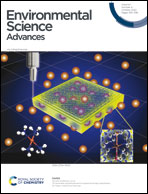Evaluating the consistency of the TRMM over the rain gauge for drought monitoring in the semi-arid region of Karnataka, India, using statistical methods†
Abstract
Nowadays there is an increase in the utilization of satellite-based precipitation products which makes it crucial to examine the accuracy of such products. The current study aims at achieving the same by validating the quality of TRMM 3B43 data along with the ground-based gauge data in the analysis of drought conditions during the period 1998 to 2019. Even though both the grid datasets represent the same rainfall resolution (0.25° × 0.25°), there is an evident difference in the analysis outcome. Hence, drought indices such as RAI, MCZI, PN, and DI are used to compare the results of the TRMM and rain gauge. The rain gauge data tend to show more drought months under all categories, especially in severe drought in comparison to the TRMM for the RAI. Chikkanayakanahalli showed 115 months of severe drought from the rain gauge while the TRMM only showed 107 months. The maximum correlation of the data was found for the MCZI at 35.2% while the minimum was for the PN with R2 being 19.3%. Statistical methods helped to create a better picture of the reliability of the dataset. Variability in the Pearson correlation is greater from September to December for all indices.



 Please wait while we load your content...
Please wait while we load your content...